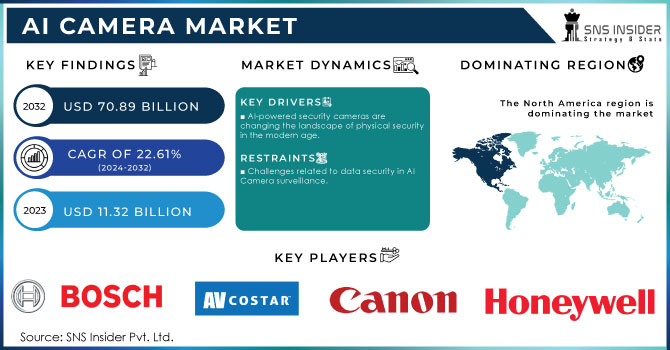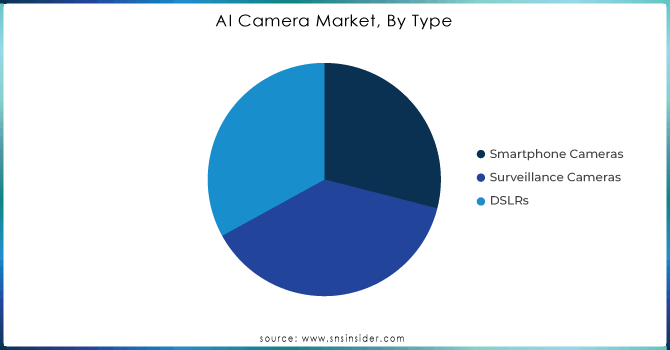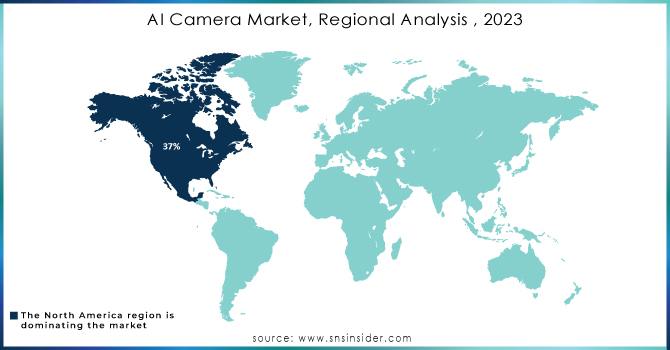AI Camera Market Size

Get PDF Sample Report on AI Camera Market - Request Sample Report
AI Camera Market Overview
The AI Camera Market size was valued at USD 11.32 billion in 2023 and is expected to grow to USD 70.89 billion by 2032 and grow at a CAGR of 22.61% over the forecast period of 2024-2032.
The rapid growth of the AI camera market is fueled by the advancements in artificial intelligence and machine learning technologies, allowing cameras to undertake tasks beyond standard imaging. AI cameras come with smart algorithms that enable them to identify objects, faces, gestures, and emotions, making them crucial for various uses. These consist of surveillance, driverless cars, mobile phones, healthcare, and retail data analysis. AI cameras in surveillance increase security by offering instant facial recognition and behavior analysis, enhancing threat detection effectively. The car market plays a crucial role by utilizing AI cameras in ADAS and autonomous driving to enhance safety and effectiveness. In the realm of smartphones, AI cameras have transformed the photography experience by introducing capabilities like scene recognition, portrait enhancement, and improving low-light photography. AI cameras in the healthcare market provide advantages in patient monitoring and diagnostics by helping to identify abnormalities or monitor patient vital signs. Retailers use AI cameras to analyze consumer behavior, enhance customer interaction, and optimize store designs. The increase of smart cities and the increasing need for automation in various sectors continue to drive the market.
The AI camera market is experiencing notable growth due to the incorporation of AI cameras in traffic management and road safety, as seen in their detection of seat belt violations in Devon and Cornwall, UK. AI cameras are being used more and more on roads to improve traffic safety by detecting unsafe behaviors like not wearing seatbelts, using mobile phones, and other risky actions while driving. This technology is capable of effectively analyzing large volumes of data, pinpointing infractions that could go unnoticed by human officers. The situation where more than 2,200 violations of seat belt laws were noted, including 109 cases with children, showcases the important contribution of AI cameras in improving road safety. By utilizing AI technology, law enforcement can identify specific infractions such as unsecured children, even in fast-moving situations, through advanced image analysis and recognition features. The increasing number of crimes reported highlights the rise in need for smart surveillance systems, particularly in areas focusing on traffic safety. Moreover, the possible implementation of harsher penalties for not wearing seat belts, supported by professionals such as Adrian Leisk, may also boost the use of AI cameras for enforcing regulations. The increase in need for AI cameras is fueling the growth of the market, especially in industries such as transportation and public safety. Governments and police forces globally are increasingly acknowledging the impact of AI in decreasing traffic incidents and improving the efficiency of law enforcement, which is projected to lead to increased investments in these technologies. In addition, AI cameras are currently being utilized to tackle important safety concerns like unsecured children in cars, leading to a market growth towards non-traditional surveillance Types affecting public health and well-being. The increasing use of AI cameras for road safety is in line with the overall trend of automation and AI incorporation in various sectors, which will contribute to continuous market expansion in the future.
| Report Attributes | Details |
|---|---|
| Key Segments | • By Type (Smartphone Cameras, Surveillance Cameras, DSLRs) • By Technology (Image/Face Recognition, Speech/Voice Recognition, Computer Vision) |
| Regional Coverage | North America (US, Canada, Mexico), Europe (Eastern Europe [Poland, Romania, Hungary, Turkey, Rest of Eastern Europe] Western Europe] Germany, France, UK, Italy, Spain, Netherlands, Switzerland, Austria, Rest of Western Europe]), Asia-Pacific (China, India, Japan, South Korea, Vietnam, Singapore, Australia, Rest of Asia-Pacific), Middle East & Africa (Middle East [UAE, Egypt, Saudi Arabia, Qatar, Rest of Middle East], Africa [Nigeria, South Africa, Rest of Africa], Latin America (Brazil, Argentina, Colombia, Rest of Latin America) |
| Company Profiles |
AV Costar, Axis Communications AB ,Bosch Sicherheitssysteme GmbH ,Canon Inc. ,Hangzhou Hikvision Digital Technology Co., Ltd. ,Honeywell International Inc. ,Huawei Technologies Co., Ltd. ,Johnson Controls ,LG Electronics ,Nikon Corporation ,Panasonic Holdings Corporation ,Samsung Electronics Co., Ltd. ,Sony Corporation ,Teledyne FLIR LLC ,Others |
AI Camera Market Dynamics
Drivers
-
AI-powered security cameras are changing the landscape of physical security in the modern age.
The use of AI in security camera monitoring is transforming the traditional approach to physical security, which has historically relied on gates, guards, and firearms. AI-driven cameras are changing security by shifting from analyzing events after they occur to being able to stop incidents before they worsen. AI cameras can offer continuous, accurate surveillance, unlike human operators who might overlook important signals. They are proficient in identifying objects, spotting potential dangers like unattended items or weapons, and can improve night vision and thermal imaging, enabling surveillance in difficult environments like dimly lit areas or identifying differences in temperature. AI also provides analysis of behavior, recognizing questionable actions or lingering, and crowd analysis aids in identifying dangers such as crowded situations. Technologies such as facial recognition and license plate recognition enhance security by improving vehicle tracking and access control efficiency. These developments pose difficulties when it comes to implementation. Privacy issues, particularly in relation to facial recognition, prompt ethical inquiries regarding consent and the improper use of data. Moreover, the obstacle of AI accuracy persists, as an abundance of false positives can inundate security personnel, resulting in the disabling of AI functionalities. Incorrect identification or lack of context can lead to overlook dangerous situations, whereas unreliable data can reduce the system's efficiency. Additionally, the significant expense of implementation, combined with difficulties in integrating with current security infrastructure, hinders widespread acceptance. Even with these obstacles, the advantages are fueling the expansion of the AI camera market. Governments and businesses are putting money into AI cameras to improve security in public areas, crucial infrastructure, and smart cities, leading to a fast growth of the global AI camera market. The growing importance of AI in developing security systems is underscored by its increasing presence in the market, as continuous advancements are anticipated to drive adoption in different industries.
-
Increasing interest from consumers for smart devices is driving expansion in the AI Camera Market.
The rise in consumer fascination with smart gadgets is a major factor influencing the AI camera market, fueled by a rising desire for enhanced functionalities and automated processes in residential and commercial settings. AI-powered cameras provide services such as identifying objects, monitoring security, and automating processes, meeting the desires of today's consumers for convenience and effectiveness. AI cameras are becoming essential tools for businesses in different sectors as they aim to enhance operational efficiency, cut expenses, and obtain valuable insights. These are commonly utilized in tasks like anomaly detection, quality control, and predictive maintenance, playing a crucial role for industries that value automation and databased decision-making. The increasing popularity of smart cities and connected infrastructure intensifies the need for collecting and analyzing real-time data, in which AI cameras stand out for their capability to process large amounts of data instantly. Market participants are reacting to this trend by creating solutions that integrate sophisticated AI features to satisfy changing consumer demands. Hanwha Vision displayed a four-channel mini AI multidirectional camera, the PNM-C16013RVQ, in December 2023, perfect for use in smart, compact settings. This camera offers operators a 360° field of view and includes AI analytics, such as virtual line and area detection, providing an efficient and robust solution at a low cost. These advancements demonstrate how AI cameras are changing to cater to the demands of both companies and Technology, stimulating market expansion. AI-powered cameras will have a crucial impact on the growth of smart devices, aiding in the ongoing progress of smart homes, cities, and industries. Due to this, it is anticipated that the AI camera market will see substantial growth, driven by increasing consumer fascination with smart technologies and the need for intelligent, automated options.
Restraints
-
Challenges related to data security in AI Camera surveillance.
AI cameras, which come with sophisticated sensors for identifying faces, detecting objects, and recognizing actions, produce and handle large amounts of data instantaneously, causing major data security hurdles. Storing and protecting video data requires strong infrastructure like secure servers, data centers, and cloud solutions. Data protection necessitates choosing suitable storage technologies and enforcing strict security measures to avoid data leakage. Transmitting data remotely from AI cameras to monitoring or analysis sites comes with extra dangers, since inadequate encryption while transferring data can result in interception or unauthorized access. Securing data requires careful control of database entry points and ensuring only approved individuals are granted access. Outdated technology or weak security protocols can make it easier for unauthorized breaches to occur in access control systems. Cybercriminals able to obtain security codes or other confidential data can breach databases in a matter of minutes. Hence, it is important to have current access controls and strong encryption methods in place to protect data from possible dangers. It is crucial to tackle these data security issues in order to safeguard the reliability of AI camera systems and prevent security weaknesses from compromising the advantages of advanced surveillance technologies.
AI Camera Market Segment Analysis
By Type
By 2023, surveillance cameras were at the forefront of the AI camera market, claiming the majority of revenue at 38%. This substantial portion highlights the important function of AI-driven surveillance technology in contemporary security measures. Surveillance cameras with artificial intelligence have enhanced features like instant object identification, tracking motion, and sending automated notifications, vital for all-encompassing security control in public and private domains. Key players in the market have achieved significant progress in this area. In January 2023, Hikvision released a new line of AI-powered surveillance cameras, the DS-2CD7A26G0/P-IZHS, which includes advanced facial recognition and intrusion detection capabilities. In the same way, Axis Communications unveiled the Axis Q1656-D in March 2023, a surveillance camera with AI capabilities, created for advanced imaging and smart video analysis. These advancements demonstrate the increasing need for advanced surveillance systems that utilize AI to improve security procedures. As the market grows, incorporating AI into surveillance cameras is predicted to lead to more advancements, providing better monitoring solutions for different uses.

Get Customized Report as per your Business Requirement - Request For Customized Report
By Technology
In 2023, the biggest portion of the AI camera market revenue was secured by image and face recognition technology, making up 38% of the total. This shows the increasing dependence on advanced AI for security and identification needs. Image and facial recognition technologies boost surveillance systems by offering precise identification and authentication capabilities, vital for various uses such as access control and public safety. Significant developments in the market demonstrate this pattern. In February 2023, Dahua Technology introduced the DH-IPC-HF81230F, an AI camera with advanced face recognition features for improved security and user authentication. Likewise, in July 2023, NEC Corporation introduced its NeoFace technology incorporated into the new NeoFace X series, with the goal of offering precise face recognition for a range of security and customer service uses. More globally, nations are making substantial investments in security infrastructure powered by artificial intelligence. An example is the United Arab Emirates integrating cutting-edge facial recognition technology into their smart city initiatives, improving urban management and public safety. These advancements highlight the crucial importance of image and facial recognition in the AI camera market, fueling both technological progress and improvements in global security.
AI Camera Market Regional Analysis
In 2023, North America dominated the AI camera market, accounting for 37% of the revenue. The region has experienced substantial regulatory and technological advancements, which are key factors contributing to this dominance. The enactment of the Foreign Intelligence Surveillance Act (FISA) by the U.S. government is a crucial factor, establishing strict guidelines for electronic surveillance operations. This law has increased the use of AI surveillance tools by creating specific regulations and legal structures that endorse their usage. There has been a significant increase in the need for advanced AI cameras that can fulfill these regulatory standards. Large companies in North America have met this demand by introducing new and creative products. In March 2023, Cisco Systems unveiled the new Cisco Meraki MV93, an AI-driven security camera with advanced analytics and improved image recognition to help meet federal surveillance rules. Likewise, in September 2023, Motorola Solutions introduced the WatchGuard V300 body-worn camera with AI capabilities, live video analysis, and automatic license plate identification, designed specifically for use in law enforcement. The progress demonstrates North America's dominant position in the AI camera market, fueled by regulatory backing and a commitment to technological progress. Incorporating AI into surveillance systems improves security and efficiency while also complying with legal standards for electronic monitoring solidifying the region is leading position in the worldwide AI camera market.
By 2023, Asia-Pacific had become the second most rapidly growing region in the AI camera market, with a high CAGR expected to drive further growth in the coming years. The region's significant population, which makes up almost half of the worldwide total, and its quickly growing economies in countries like India, South Korea, Japan, and Australia, are driving this expansion. Growing investments in advanced technology-based electronic devices and supportive government programs are pushing the use of AI cameras in different Types. An example worth mentioning is the launch of AI-powered cameras for traffic control by the Delhi government in January 2024. The purpose of these cameras is to identify 19 different traffic infractions, such as using a mobile phone while driving, having multiple passengers on a two-wheeler, and driving without a valid Pollution Under Control Certificate (PUCC). The demand for AI-powered cameras in connected devices is predicted to increase in Asia-Pacific as economies develop and urbanize, driven by government projects and private sector investments. The incorporation of AI technologies in this area highlights its increasing influence on the global AI camera market, emphasizing its dedication to using innovative solutions for better safety and productivity.

KEY PLAYERS
Some of key players of AI Camera Market who offer Product and Offering
-
AV Costar (Costar VMS)
-
Axis Communications AB (Axis Q1656-D AI Camera)
-
Bosch Sicherheitssysteme GmbH (Bosch AUTODOME IP starlight 7000i)
-
Canon Inc. (Canon VB-H43 AI Camera)
-
Hangzhou Hikvision Digital Technology Co., Ltd. (Hikvision DS-2CD7A26G0/P-IZHS)
-
Honeywell International Inc. (Honeywell Pro-Watch® Integrated Security Suite)
-
Huawei Technologies Co., Ltd. (Huawei OceanStor Dorado AI Camera)
-
Johnson Controls (Tyco Illustra Pro Gen 3 AI Camera)
-
LG Electronics (LG AI Video Surveillance Solutions)
-
Nikon Corporation (Nikon DS-Fi3 AI Camera)
-
Panasonic Holdings Corporation (Panasonic i-PRO Extreme AI Camera)
-
Samsung Electronics Co., Ltd. (Samsung Wisenet P Series AI Cameras)
-
Sony Corporation (Sony SNC-VB770 AI Camera)
-
Teledyne FLIR LLC (FLIR A500/A700 AI Thermal Cameras)
-
Others
Recent Development
-
On June 23, 2024, Nikon announced it is developing new technology to authenticate images and differentiate them from AI-generated fakes. This innovation aims to combat the growing issue of AI-created disinformation, a challenge that highlights the increasing importance of reliable imaging technologies in the AI camera market.
-
In February 2024, NWSL and Google Pixel revealed the introduction of the Program for Pitchside Content featuring AI Cameras. Through the long-term collaboration, Google Pixel is now the official sponsor of the NWSL Championship and Playoffs, in addition to introducing the Pixel program to enhance fan engagement with the sport.
-
In October 2023, Panasonic incorporated AI-driven automatic tracking into its PTZ cameras. The system is ideal for news studios, enabling users to capture all necessary content with only one operator needed to handle cameras.
-
In October 2023, Teledyne FLIR announced the launch of Visible Security Cameras integrated with artificial intelligence at ISC West 2023, enhancing its product range. The FLIR Quasar Premium Mini-Dome AI comes in three versions: 4K Wide, 5 MP, and 4K Narrow. Each option includes 12 analytics for detecting individuals, items, cars, occurrences, and characteristics.
| Report Attributes | Details |
|
Market Size in 2023 |
USD 11.32 billion |
|
Market Size by 2032 |
USD 70.89 billion |
|
CAGR |
CAGR of 22.61 % From 2024 to 2032 |
|
Base Year |
2023 |
|
Forecast Period |
2024-2032 |
|
Historical Data |
2020-2022 |
|
Report Scope & Coverage |
Market Size, Segments Analysis, Competitive Landscape, Regional Analysis, DROC & SWOT Analysis, Forecast Outlook |
|
Market Opportunities |
• AI-powered security cameras are changing the landscape of physical security in the modern age. |
|
Market Restraints |
• Challenges related to data security in AI Camera surveillance. |

